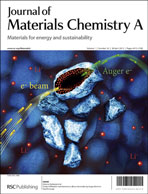Despite many studies, silicon lithiation mechanisms remain unclear. Si amorphization induced by lithium insertion hinders the use of standard techniques of characterization such as diffraction. In this paper, electrochemical silicon lithiation is investigated by using a technique of surface characterization, Auger Electron Spectroscopy (AES). The first part of this work has been dedicated to evaluating the possibility of studying Li–Si alloys with AES: well-known crystalline LixSi alloys were successfully synthesized and analyzed. Based on the Auger results, Alloy Reference Relative Sensitivity Factors (ARRSFs) were determined for each alloy. After this step, several Si-electrodes were scrutinized at different Depths Of Discharge (DOD) during the first lithiation. The very high spatial resolution of AES allowed us to investigate individual silicon particles with respect to their electrode environment and study the lithiation mechanisms which occur at the particle scale. The core–shell model is confirmed: Si lithiation starts with the formation of a Li-rich shell surrounding a core of pure silicon. By using the ARRSFs calculated previously, an accurate composition of this shell can be determined: Li3.1Si. This phase grows upon lithiation resulting in a progression of the two-phase boundary inside the particle at least until a discharge capacity of 1800 mA h g−1. AES appears then as a very valuable technique to better understand the lithium insertion process in silicon as well as the failure mechanisms of Si-electrodes and can help in the development of high performance Si materials.

You have access to this article
 Please wait while we load your content...
Something went wrong. Try again?
Please wait while we load your content...
Something went wrong. Try again?


 Please wait while we load your content...
Please wait while we load your content...